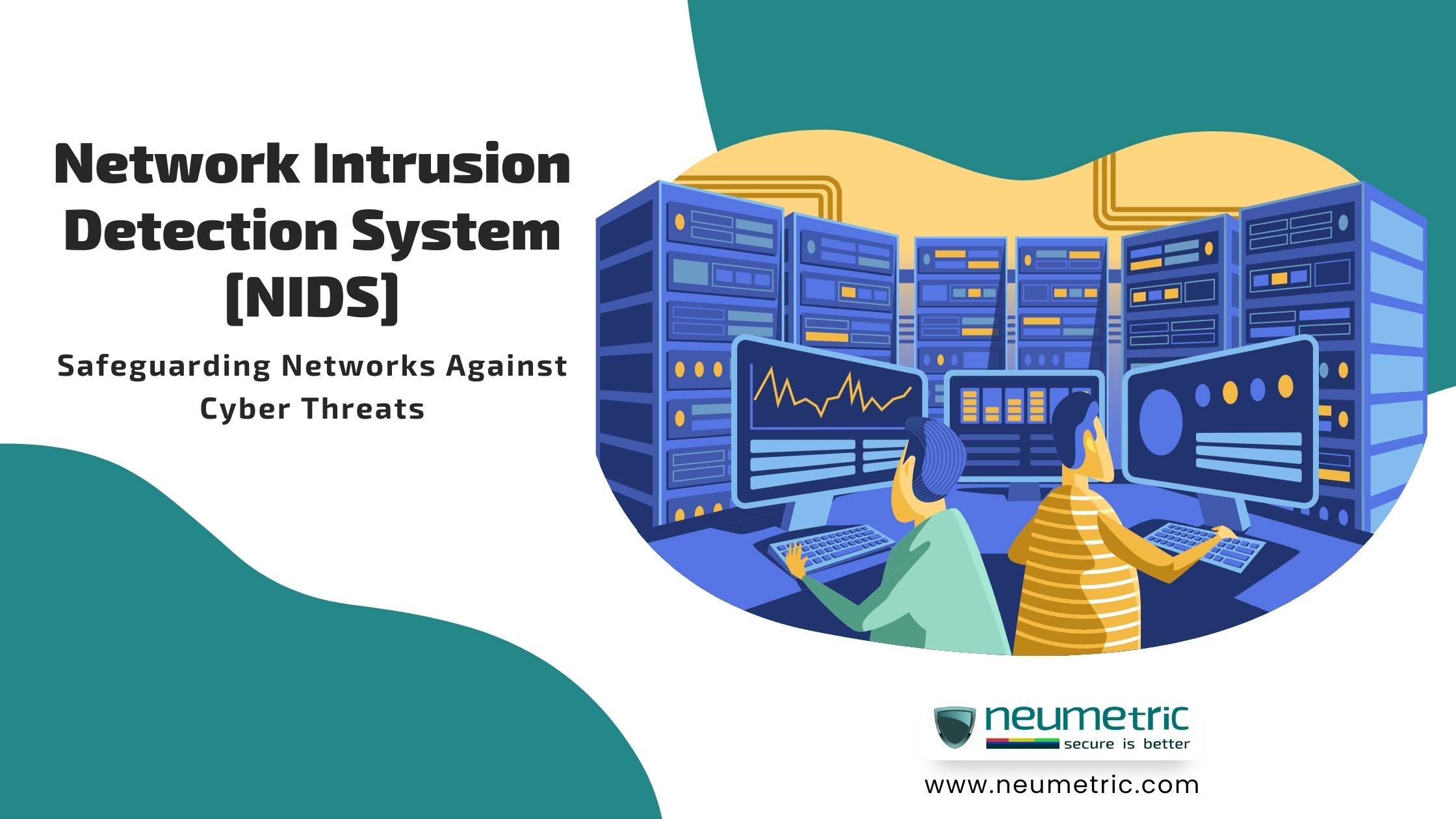Table of Contents
ToggleNetwork Intrusion Detection System [NIDS]: Safeguarding networks against cyber threats
Introduction
The modern digital landscape is plagued by an ever-escalating wave of cyber threats that relentlessly target networks of all sizes & industries. From sophisticated nation-state attacks to opportunistic malware campaigns, the threat actors behind these incursions are becoming more resourceful & inventive with each passing day. In this era of hyper-connectivity & data-driven operations, safeguarding networks against these pervasive cyber threats has become an imperative for organisations worldwide.
Network Intrusion Detection Systems [NIDS] is a vital defence mechanism that stands as a bulwark against the onslaught of cyber intrusions. NIDS represents a sophisticated array of technologies & methodologies designed to monitor network traffic for any signs of unauthorised access, malicious activities or anomalous behaviour. Unlike traditional firewalls that mainly focus on controlling incoming & outgoing traffic, NIDS takes a proactive approach by scrutinising network packets in real-time, identifying potential threats that might evade conventional security measures.
This Journal explores NIDS in network security, covering its importance, operation & evolving threat landscape. It aims to inform professionals about NIDS’ capabilities, limitations & advancements for risk mitigation & network integrity.
Understanding NIDS
Network Intrusion Detection Systems [NIDS] constitute a critical component of contemporary cybersecurity strategies, serving as vigilant sentinels guarding against the relentless tide of cyber threats. NIDS are specialised tools designed to survey & analyse network traffic, aiming to identify & thwart unauthorised access, malicious activities & anomalous behaviour that could signify a cyber attack.
Unlike Network Intrusion Prevention Systems [NIPS], which actively intervene to block suspicious traffic, NIDS operate in a more passive mode, functioning as watchful observers. Their primary objective is to identify potential threats without disrupting the flow of legitimate network operations. This differentiation allows NIDS to provide valuable insights into emerging attack trends, aiding in the refinement of defensive measures & incident response strategies.
NIDS monitor network traffic for unusual patterns or attack signatures using signature & anomaly detection. This dual approach identifies known & emerging threats. NIDS serve as early warnings, allowing cybersecurity responses before breaches escalate. This exploration highlights NIDS’ operational mechanics, importance & role in defending digital networks. In a dynamic cyber landscape, NIDS are vital for safeguarding modern digital infrastructure & preserving security.
Types of NIDS
NIDS cover diverse methods for countering cyber threats, addressing unique network security challenges. Three main NIDS types stand out as crucial defenders in this complex landscape.
Signature-based NIDS operates on a well-defined playbook, identifying attacks by comparing network traffic to established signatures of known attack patterns. This method excels at swiftly identifying recognized threats but may falter against novel or disguised attacks.
Anomaly-based NIDS takes a more dynamic approach, scrutinising network activity to discern deviations from established norms. By building profiles of expected behaviour, this method can flag activities that deviate significantly from the baseline, potentially indicating the presence of a new, previously unseen threat.
Hybrid NIDS represents a synthesis of both signature & anomaly detection techniques. By melding the strengths of both approaches, hybrid NIDS can detect both known & emerging threats. It leverages signature databases for swift recognition of established attacks while maintaining the ability to adapt to evolving tactics.
Choosing a NIDS type depends on an organisation’s security goals, risk tolerance & threat environment. As cyber threats evolve, grasping these NIDS nuances is vital for forming a robust defence system against varied intrusions.
Key benefits of NIDS
NIDS are crucial for enhancing network security, providing several benefits against evolving cyber threats. Their key advantage lies in early breach detection & response. Through constant traffic monitoring, NIDS can promptly spot anomalies, empowering security teams to proactively counter potential attacks before significant harm occurs.
NIDS offer a dual defence strategy, safeguarding networks from both recognized & unfamiliar threats. Signature-based detection enables swift response to established attack patterns, while anomaly-based detection lets NIDS identify new deviations, enhancing their adaptability to emerging attack methods.
The real-time monitoring feature of NIDS stands as another significant advantage. By analysing network traffic as it unfolds, NIDS offer a continuous snapshot of the network’s security status. This real-time visibility facilitates prompt identification of suspicious activities & potential vulnerabilities, allowing security teams to respond swiftly & mitigate risks.
Additionally, NIDS contribute to compliance efforts by helping organisations adhere to regulatory requirements. The continuous monitoring of network activities aligns with the mandates of data protection regulations & industry standards, ensuring that organisations maintain a robust security posture to safeguard sensitive data & prevent potential breaches.
The NIDS workflow
In the complex landscape of cybersecurity, Network Intrusion Detection Systems [NIDS] stand as vigilant sentinels, safeguarding networks against a multitude of cyber threats. The workflow of NIDS comprises a well-defined series of steps, each contributing to the system’s ability to proactively detect, respond to & mitigate potential breaches.
- Traffic analysis & capture: At the core of NIDS lies the meticulous analysis & capture of network traffic. This stage involves capturing both incoming & outgoing traffic, scrutinising data packets for signs of malicious or unauthorised activities. Technologies like Deep Packet Inspection [DPI] enable NIDS to delve into the intricate layers of network data, deciphering the contents & extracting valuable insights.
- Pattern recognition & anomaly detection: NIDS excel in recognizing & classifying patterns of network behaviour. Signature-based detection involves comparing network traffic to an extensive database of known attack patterns. This enables swift identification of familiar threats. Complementing this, anomaly detection comes into play by identifying deviations from established baseline behaviour. This adaptive approach allows NIDS to uncover previously unseen threats, providing a more comprehensive defence mechanism.
- Alert generation & notification: Upon identifying suspicious activities, NIDS generate alerts as a precursor to proactive incident response. These alerts serve as early warnings, signalling potential breaches or vulnerabilities. Security teams are promptly notified, initiating the crucial investigative phase. The efficient generation & dissemination of alerts enhance the organisation’s ability to respond rapidly to potential threats.
- Incident response & mitigation: The incident response phase is characterised by a collaborative effort to address & mitigate potential threats. Security teams leverage the insights provided by NIDS alerts to delve into the nature & scope of the incident. Additionally, NIDS integrate seamlessly with other security tools, enabling automated responses to specific threats. This integration fosters a cohesive & well-coordinated defence strategy.
Challenges & considerations
As reliance on Network Intrusion Detection Systems [NIDS] grows for cybersecurity, challenges arise. Balancing precise threat detection with low false positives is crucial. High accuracy matters, yet too many false positives strain security teams, risking oversight of real threats. NIDS designers must refine detection algorithms, using advanced machine learning to enhance accuracy & minimise false alerts.
The evolving landscape of cyber threats poses another significant challenge. Attack techniques & strategies continuously evolve, demanding that NIDS stay updated & adaptable. Cybercriminals are adept at evading detection, necessitating frequent updates to signature databases & proactive exploration of emerging threat vectors. This challenge underscores the importance of regular system maintenance, threat intelligence integration & staying abreast of the latest attack trends.
An equally important consideration revolves around privacy concerns associated with network monitoring. Organisations must tread carefully to ensure that NIDS implementations respect user privacy, data protection regulations & legal requirements. Transparent communication regarding network monitoring policies, data storage practices & consent mechanisms is imperative to foster trust between organisations & their users.
Best practices for effective NIDS implementation
Network Intrusion Detection Systems [NIDS] play a critical role in defending against cyber threats & their effective implementation requires a strategic approach. To maximise their efficacy, several best practices should be followed.
Firstly, proper network segmentation & thorough traffic analysis are essential. By categorising network assets & segmenting them based on their importance & sensitivity, organisations can enhance the precision of NIDS alerts. This practice ensures that resources are allocated efficiently to monitor critical areas & minimise the risk of unnecessary alerts stemming from less vital network segments. In tandem with segmentation, detailed traffic analysis helps NIDS differentiate between normal & suspicious activities, enabling accurate threat detection.
Frequent signature database & detection rule updates are vital due to fast-evolving cyber threats. NIDS should automate updates to stay current & adept at detecting emerging dangers. Integration with Security Information & Event Management [SIEM] amplifies security. SIEM merges data from diverse sources, letting teams link NIDS alerts with context, boosting incident response & holistic security awareness.
Future trends in NIDS
The landscape of Network Intrusion Detection Systems [NIDS] is poised for remarkable transformation as emerging trends promise to reshape the way organisations defend their networks against cyber threats.
Artificial Intelligence [AI] & Machine Learning [ML] integration propel NIDS evolution. They enable behaviour-based detection, surpassing signatures. AI-powered NIDS learn network & user patterns, spotting anomalies & elusive threats. This boosts accuracy, curbs false positives & streamlines security teams.
The proliferation of cloud computing & hybrid environments introduces new challenges & opportunities for NIDS. As networks expand beyond traditional boundaries, NIDS must adapt to monitor traffic across diverse platforms. Cloud-compatible NIDS solutions are emerging, capable of monitoring both on-premises & cloud-based environments. This ensures consistent threat detection & response, regardless of the network’s architecture.
Furthermore, the need to decrypt encrypted network traffic is becoming increasingly crucial. While encryption enhances data privacy, it can also conceal malicious activities. Future NIDS solutions are anticipated to enhance their visibility into encrypted traffic without compromising privacy, striking a delicate balance between security & confidentiality.
Conclusion
In the ever-evolving realm of cybersecurity, Network Intrusion Detection Systems [NIDS] stand as stalwart guardians, diligently protecting networks from a dynamic array of threats. Throughout this Journal, we’ve traversed the landscape of NIDS, delving into their architecture, benefits, challenges & future prospects.
NIDS emerge as more than just tools; they are integral components of a robust defence strategy. Their capability to provide early threat detection, real-time monitoring & prompt incident response underscores their pivotal role in safeguarding network integrity. As organisations contend with increasingly sophisticated cyber threats, the importance of adopting NIDS cannot be overstated.
Considering the Journal’s insights, we strongly urge organisations to adopt NIDS as a cybersecurity cornerstone. Real cases, practices & trends highlight NIDS’ immense value in modern network defence. By making NIDS a core security element, organisations enhance networks, mitigate risks & ensure safer digital operations. As NIDS advance, they continue as vital guardians of the digital realm.
FAQ
What is NIDS in cyber security?
Network Intrusion Detection System [NIDS] is a cybersecurity technology that monitors network traffic for unauthorised or malicious activities, aiming to promptly detect & alert security personnel about potential cyber threats. NIDS plays a vital role in enhancing network security by identifying patterns that indicate attacks, enabling timely responses to mitigate risks.
What are NIDS used for?
Network Intrusion Detection Systems [NIDS] are employed to monitor network traffic in real-time, identifying unauthorised access, malicious activities & anomalies. They play a crucial role in early threat detection, helping organisations swiftly respond to potential cyber threats, mitigate risks & ensure the security of their digital infrastructure.
What does NIDS mean?
Network Intrusion Detection System [NIDS] refers to a cybersecurity tool that monitors network traffic for suspicious or unauthorised activities, helping to identify potential cyber threats & vulnerabilities in real-time, enabling proactive responses to enhance network security.
What is the difference between NIDS & IPS?
The main distinction between Network Intrusion Detection Systems [NIDS] & Intrusion Prevention Systems [IPS] lies in their actions. NIDS passively monitor network traffic, detecting & alerting administrators about potential threats. On the other hand, IPS not only detects threats but also actively intervenes to block or prevent identified threats from entering the network, offering a more proactive defence mechanism.





